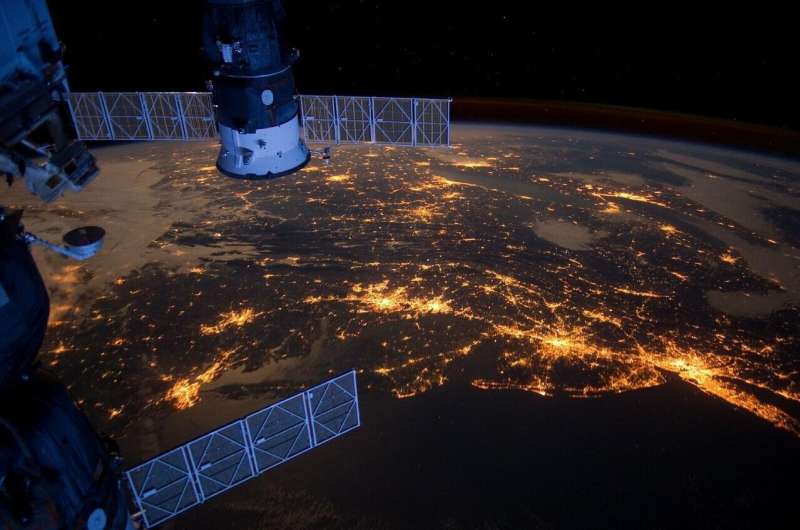New method could decrease number of satellites needed for global coverage
Low-orbit satellites could soon offer millions of people worldwide access to high-speed communications, but the satellites’ potential has been stymied by a technological limitation—their antenna arrays can only manage one user at a time.
The one-to-one ratio means that companies must launch either constellations of many satellites, or large individual satellites with many arrays, to provide wide coverage. Both options are expensive, technically complex, and could lead to overcrowded orbits.
For example, SpaceX went the “constellation” route. Its network, StarLink, currently consists of over 6,000 satellites in low-Earth orbit, over half of which were launched in the past few years. SpaceX aims to launch tens of thousands more in the coming years.
Now, researchers at Princeton engineering and at Yang Ming Chiao Tung University in Taiwan have invented a technique that enables low-orbit satellite antennas to manage signals for multiple users at once, drastically reducing needed hardware.
In a paper, titled “Physical Beam Sharing for Communications with Multiple Low Earth Orbit Satellites” published June 27 in IEEE Transactions on Signal Processing, the researchers describe a way to overcome the single-user limit. The strategy builds on a common technique to strengthen communications by positioning antenna arrays to direct a beam of radio waves precisely where it’s needed.
Each beam carries information, like texts or phone calls, in the form of signals. While antenna arrays on terrestrial platforms such as cell towers can manage many signals per beam, low-orbit satellites can only handle one.
The satellites’ 20,000 miles-per-hour speed and constantly changing positions make it nearly impossible to handle multiple signals without jumbling them.
“For a cell tower to communicate with a car moving 60 miles per hour down the highway, compared to the rate that data is exchanged, the car doesn’t move very much,” said co-author H. Vincent Poor, the Michael Henry Strater University Professor in Electrical and Computer Engineering at Princeton. “But these satellites are moving very fast to stay up there, so the information about them is changing rapidly.”
To deal with that limitation, the researchers developed a system to effectively split transmissions from a single antenna array into multiple beams without requiring additional hardware. This allows satellites to overcome the limit of a single user per antenna array.
Co-author Shang-Ho (Lawrence) Tsai, professor of electrical engineering at Yang Ming Chiao Tung University, compared the approach to shining two distinctive rays from a flashlight without relying on multiple bulbs. “Now, we only need one bulb,” he said. “This means a huge reduction in cost and power consumption.”
A network with fewer antennas could mean fewer satellites, smaller satellites, or both. “A conventional low Earth orbit satellite network may need 70 to 80 satellites to cover the United States alone,” Tsai said. “Now, that number could be reduced to maybe 16.”
The new technique can be incorporated into existing satellites that are already built, according to Poor. “But a key benefit is that you can design a simpler satellite,” he said.
Impacts in space
Low-orbit satellites reside in the lower layer of Earth’s atmosphere, between 100 and 1,200 miles from the surface. This region of space offers limited real estate. The more objects flying around, the more likely they are to crash, breaking apart and releasing smaller fragments of debris that can then crash into other objects.
“The concern there isn’t so much getting hit by a falling satellite,” Poor said, “But about the long-term future of the atmosphere, and the orbit being clouded up with space debris causing problems.”
Because the low-orbit satellite industry is gaining traction at a rapid pace, with companies including Amazon and OneWeb deploying their own satellite constellations to provide internet service, the new technique has the potential to reduce the risk of these hazards.
Poor said that while this paper is purely theoretical, the efficiency gains are real. “This paper is all mathematics,” he said. “But in this field in particular, theoretical work tends to be very predictive.”
Since publishing the paper, Tsai has gone on to conduct field tests using underground antennas and has shown that the math does, in fact, work. “The next step is to implement this in a real satellite and launch it into space,” he said.
More information:
Yan-Yin He et al, Physical Beam Sharing for Communications With Multiple Low Earth Orbit Satellites, IEEE Transactions on Signal Processing (2024). DOI: 10.1109/TSP.2024.3408061
Princeton University
Citation:
New method could decrease number of satellites needed for global coverage (2024, September 13)
retrieved 14 September 2024
from https://techxplore.com/news/2024-09-method-decrease-satellites-global-coverage.html
This document is subject to copyright. Apart from any fair dealing for the purpose of private study or research, no
part may be reproduced without the written permission. The content is provided for information purposes only.

Comments are closed